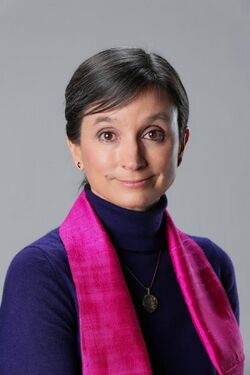Biography:Kathryn Hess
Kathryn Hess Bellwald | |
|---|---|
 Kathryn Hess Bellwald in 2019 | |
| Born | September 21, 1967 Bryn Mawr, Pennsylvania, US |
| Alma mater | University of Wisconsin–Madison Massachusetts Institute of Technology |
| Awards | |
| Scientific career | |
| Fields | Mathematics |
| Institutions | École Polytechnique Fédérale de Lausanne (EPFL) |
| Doctoral advisor | David Jay Anick |
Kathryn Pamela Hess (born 1967)[1] is an American mathematician who has served as professor of mathematics at École Polytechnique Fédérale de Lausanne (EPFL) since 1999. She is known for her work on homotopy theory, category theory, and algebraic topology, both pure and applied. In particular, she applies the methods of algebraic topology to the study of neurology[2], cancer biology, and materials science. She is a fellow of the American Mathematical Society.
Life
Kathryn Hess was born 21 September 1967 in Bryn Mawr, Pennsylvania. She began to accelerate in mathematics in 1979, thanks to the Mathematical Talent Development Project (MTDP) set up in Eau Claire, Wisconsin, by her parents, through the Association for High Potential Children, which they also founded. Both programs are currently defunct. Hess earned a BSc with honors in mathematics from the University of Wisconsin–Madison in 1985.[2] She received her doctorate in mathematics from the Massachusetts Institute of Technology in 1989 under the direction of David J. Anick (de). Her dissertation was entitled A Proof of Ganea's Conjecture for Rational Spaces.[H91][3]
Work
Hess has worked and written extensively on topics in algebraic topology including homotopy theory, model categories[H02] and algebraic K-theory.[HS] She has also used the methods of algebraic topology and category theory to investigate homotopical generalizations of descent theory[H10] and Hopf–Galois extensions.[H09] In particular, she has studied generalizations of these structures for ring spectra and differential graded algebras.
She has more recently used algebraic topology to understand structures in neurology[KDS][DHL] and materials science.[LBD]
As of March 2022, she has been the principal academic advisor for 14 mathematics PhDs at EPFL, including 4 women[3].
Awards and honors
In addition to her strong publication record, Hess has been widely recognized for her pedagogical abilities. She received the Agepoly prize for best teacher in the Basic Sciences Faculty in 2005, the Credit Suisse prize for best EPFL teacher in 2012, and the "Polysphere d'Or" Agepoly prize for best teacher at EPFL in 2013.[4]
She was named an individual member of the Swiss Academy of Engineering Sciences in 2016 and a fellow of the American Mathematical Society for "contributions to homotopy theory, applications of topology to the analysis of biological data, and service to the mathematical community" in 2017.[5] In 2017, she received an award as a distinguished speaker of the European Mathematical Society. She delivered one of the public lectures during the Eighth European Congress of Mathematics on 21 June 2021. Hess was named a fellow of the Association for Women in Mathematics in the class of 2024 "for her support of women in mathematics via innovative and impactful programs, including her role in founding and sustaining the Women in Topology program; for her exceptional mentoring; and for her commitment to gender diversity throughout her many leadership roles in the mathematics profession."[6]
Selected publications
| H91. | Hess, Kathryn P. (1991). "A proof of Ganea's conjecture for rational spaces" (in en). Topology 30 (2): 205–214. doi:10.1016/0040-9383(91)90006-p. |
| H02. | Hess, Kathryn (2002). "Model categories in algebraic topology" (in en). Applied Categorical Structures 10 (3): 195–220. doi:10.1023/A:1015218106586. |
| H09. | Hess, Kathryn (2009). "Homotopic Hopf–Galois extensions: Foundations and examples". New topological contexts for Galois theory and algebraic geometry (BIRS 2008). Geom. Topol. Monogr.. 16. pp. 79–132. doi:10.2140/gtm.2009.16.79. http://www.msp.warwick.ac.uk/gtm/2009/16/p005.xhtml. |
| H10. | Hess, Kathryn (2010). A general framework for homotopic descent and codescent. Bibcode: 2010arXiv1001.1556H. |
| DHL. | Dotko, Pawe; Hess, Kathryn; Levi, Ran; Nolte, Max; Reimann, Michael; Scolamiero, Martina; Turner, Katharine; Muller, Eilif et al. (2016). "Topological analysis of the connectome of digital reconstructions of neural microcircuits". Frontiers in Computational Neuroscience 11: 48. doi:10.3389/fncom.2017.00048. PMID 28659782. Bibcode: 2016arXiv160101580D. |
| HS. | Hess, Kathryn; Shipley, Brooke (2016). "Waldhausen K-theory of spaces via comodules". Advances in Mathematics 290: 1079–1137. doi:10.1016/j.aim.2015.12.019. |
| KDS. | Kanari, Lida; Dłotko, Paweł; Scolamiero, Martina; Levi, Ran; Shillcock, Julian; Hess, Kathryn; Markram, Henry (2016). "Quantifying topological invariants of neuronal morphologies". arXiv:1603.08432 [q-bio.NC]. |
| LBD. | Lee, Yongjin; Barthel, Senja D.; Dłotko, Paweł; Moosavi, S. Mohamad; Hess, Kathryn; Smit, Berend (2017). "Pore-geometry recognition: on the importance of quantifying similarity in nanoporous materials". arXiv:1701.06953 [cond-mat.mtrl-sci]. |
References
- ↑ Birth year from ISNI authority control file, retrieved 2018-11-28.
- ↑ 2.0 2.1 "Prof. Kathryn Hess Bellwald | UPHESS" (in en). http://hessbellwald-lab.epfl.ch/HessBellwald.
- ↑ 3.0 3.1 Kathryn Hess at the Mathematics Genealogy Project
- ↑ https://www.epfl.ch/labs/hessbellwald-lab/wp-content/uploads/2018/10/CV_0416.pdf [bare URL PDF]
- ↑ "2017 Class of the Fellows of the AMS" (in en-US). American Mathematical Society. https://www.ams.org/profession/ams-fellows/new-fellows.
- ↑ "2024 AWM Fellows". https://awm-math.org/awards/awm-fellows/2024-awm-fellows/.
External links
 |

